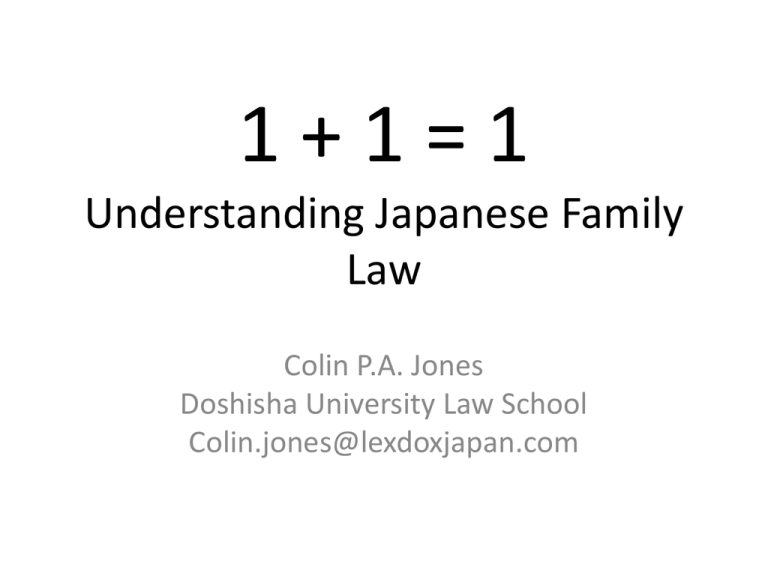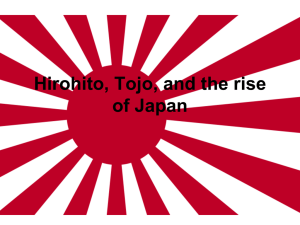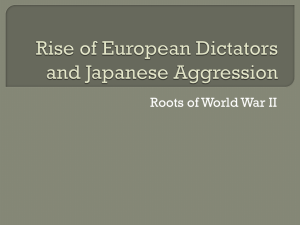
1+1=1
Understanding Japanese Family
Law
Colin P.A. Jones
Doshisha University Law School
Colin.jones@lexdoxjapan.com
Speaker Introduction : Colin P.A. Jones
colin.jones@lexdoxjapan.com
• UC Berkeley (A.B.), Tohoku Unviersity (LL.M.) Duke Law
School (J.D. /LL.M.)
• Professor, Doshisha Law School (Kyoto)
• Lawyer:
– Guam and New York
– Palau (inactive)
– Not admitted to practice in Japan
• Life Member, Clare Hall, The University of Cambridge
• Professional Translator (Japanese > English legal documents
only); founder, LexDox Japan (www.lexdoxjapan.com)
• Mediator/arbitrator candidate registered with Osaka Bar
Association dispute resolution center
Basic features of Japanese family law (1/2)
• There is no real constitutional dimension to family
law (i.e., no constitutionally-protected liberty
interest in getting married, divorced, raising
children, etc.)
• It is derived from two bodies of statutory law
– the Civil Code (Part IV), which defines legally-significant
family relationships
– the Family Register Act, which establishes the family
register system in which these relationships are
recorded
• Closest American analogy: a real estate title registry?
• Court practice and rules have also added a
significant amount of substantive “law” (e.g., child
support guidelines, rules for defacto marriages)
Basic features of Japanese family law (2/2)
• It is rooted in a system of extended families living in a
single household (ie), the head of whom once had
superior legal status.
• It is based in a registry system (the koseki) that exists to
facilitate the implementation of government policy and
identify “the family” for purposes of legal interactions
between its members and the rest of society (including
the government)
• The ie system was formally abolished during the US
occupation, but still casts a shadow across 21st century
family law.
The ie (house) system in the Pre-occupation Civil Code
• “The head of and the members of the house bear the name
of the house. “(Art. 746)
• “The head of the house is bound to support its members.
“(Art. 747)
• “….Property as to which it is uncertain whether it belongs to
the head of the house or to a member is presumed to belong
to the former. “(Art. 748)
• “A member of a house may not choose his residence against
the will of the head of the house….” (Art. 749)
• “If a member of a house desires to marry or enter into a
relation of adoption, he must obtain the consent of the head
of his house…” (Art. 750).
• Head of household status was heritable
– Usually by the eldest legitimate male
– Loss of Japanese nationality rendered one ineligible!
Pre-occupation Family law
• “Houses” (not individuals) were the smallest social unit
subject to governance
• Individual houses and their heads were granted broad
autonomy, with few formal protections for legally inferior
members (particularly women).
• Members entered the house through marriage and/or
adoption, left through divorce or dissolution of adoptive
relationships.
• Houses (and who was head) were identified in the family
register system.
• The family register system enabled the government to
implement policy (taxation, conscription, etc.) through
heads of households.
• Family register details (it was a public document until
1976!) also facilitated commercial dealings between the
household and the rest of society.
The Constitution of Japan (1947)
Article 14. (1) All of the people are equal under the law
and there shall be no discrimination in political, economic
or social relations because of race, creed, sex, social
status or family origin.
Article 24. (1) Marriage shall be based only on the mutual
consent of both sexes and it shall be maintained through
mutual cooperation with the equal rights of husband and
wife as a basis.
(2) With regard to choice of spouse, property rights,
inheritance, choice of domicile, divorce and other matters
pertaining to marriage and the family, laws shall be
enacted from the standpoint of individual dignity and the
essential equality of the sexes.
New Constitution, new family law?
• Being incompatible with the new constitution,
the ie system (and “head of house”) were
removed from the Civil Code when it was
substantially amended in 1947.
• BUT efforts were made to preserve elements of
the ie system in the Family Register Act, so that it
could be reestablished after the American
occupation (this did not happen).
• The current family register is a compromise
– The Japanese wanted a “family”-based register system
– The Americans wanted individual registration, but
settled on a family-based one on the condition that no
more than two generations could be registered
together.
Features of the current system 1/5
• The family register is based primarily on marriage,
secondarily on children – not individuals
– Japanese couples who marry must establish a new
family register: 1+1 = 1!
• If they have a child, the child will also be reflected in the
same register: 1+1+1 = 1!
– If a Japanese woman has a child out of wedlock, she
must establish a new family register reflecting the
child 1+1=1!
• Surnames are also central to the system: those in
a single register must share the same surname.
Under the Civil Code a married couple must have
the same surname (Art. 750) and children born
out of wedlock must have the mother’s surname
(Art. 790(2)).
Features of the current system 2/5
• The system is inherently discriminatory in two basic
respects
– By nationality: only Japanese citizens are registered.
• If a Japanese national marries a foreign national, the Japanese
national must establish a new family register (1+1=1 again!)
• the foreign national is not registered (appears as a marginal
notation)
• no need to have the same surname.
• Children are reflected in the Japanese parent’s register
– By legitimacy/parent’s marital status:
• The Civil Code treats contains various rules that treat children
differently depending upon legitimacy/parents’ marital status
– E.g., Surname (Art. 790(2), locus of parental authority (Arts. 818 &
819) and (until 2013) inheritance rights (Art. 900(iv)).
Features of the current system 3/5
• The system created by the family register and the Civil Code is
designed to facilitate the government’s (and other parties’)
dealings with a particular family by minimizing ambiguity about
the legal status of family relationships.
– E.g., locus of “parental authority” should always be apparent from
the family register (joint exercise only allowed during marriage).
– Marriage, divorce only take effect when registered
• An official extract of a family register is a basic form of
identification (e.g. for a passport application)
– Provides a current snapshot of family status that is more complete
than Western “event-based” systems of identification (i.e., marriage
certificate, divorce decree)
• Does not reflect internal family realities (residential
arrangements, who is the primary caregiver, etc.)
• The family register is tied primarily to nationality, not
residence:
– Japanese nationals may get married, divorced or even adopt
through family register filings mailed from abroad or filed with their
local consulate!
Features of the current system 4/5
• The register system is based primarily on consensual
“transactions”; marriage, adoption (as adults), divorce
and dissolutions of adoptive relationships
• Most “transactions” are completed by filing a form with
local authorities who have no discretionary authority
– It is relatively easy to make a fraudulent filing
• 90% of divorces (including allocations of parental
authority) accomplished this way
• Judicial resolutions are the exception for when parties
can’t agree on a consensual result
– Even when courts do get involved, procedure first involves
judicially-supported efforts to arrive at consensus
• Judicial resolutions are reflected in the family register
– Nobody ever needs to show a divorce/custody decree in
Japan, because aspects of family status that are relevant to
dealings with third parties are reflected in the register.
Features of the current system 5/5
• Although not framed in such terms, the Japanese
system of family law essentially results in disputes of
two basic categories:
– Those about matters that potentially affect the rest of
society and are reflected in the family register (e.g., marital
status, parental authority)
– Those that are really only between parties within the
family relationship (e.g., physical custody, access, child
support, etc.) and are not reflected in the family register
• The latter category is often more important to the
parties, while the former often seems more important
to courts and other government actors (the former
generally take more time to resolve through the courts)
Real-life (pre-Hague) scenario
American man (A), Japanese woman (J) are
married, have a child (C) and live in the United
States. J plans to take C to Japan for the
summer to see grandparents. J asks A to sign a
form. He cannot read Japanese. H tells him it is a
summer school application. He signs it. She and
C go to Japan and never come back.
C goes to Japan to find J and C. By the time
he does he discovers that:
Real life scenario
• The paper he signed was a divorce registration that gave
her parental authority over C; and
• J has subsequently remarried a Japanese man (X)
• X has adopted C as his own child
– This is a common practice when a woman remarries (otherwise
the child would have a different surname and 1+1+1 would = 2,
rather than 1!)
– Can be done merely through a family register filing, without the
consent of the natural father or court involvement if the
adoption is by a spouse or lineal ascendant of the parent acting
as legal guardian! (Civil Code arts. 797-798)
“A” consults a Japanese lawyer (L). L tells him to fix the
situation would require three different lawsuits, one to void
the divorce, one to void the remarriage, and another to void
the adoption. L advises him the process would take a long
time, and suggests that he is a young man and should maybe
just starting over instead.
Practice takeaways
• For family cases involving Japanese parties living
anywhere in the world, confirmation of family status
(and nationality) should be sought through an official
extract of family register
– Note: Japanese law does not allow for dual nationality
beyond the age of 22.
• Remember, Japanese people can conduct certain types
of family law transactions (divorce, etc.) anywhere in
the world
• A detailed US court judgment may not be as useful as
you might think
– Distinction between those aspects that can be reflected in
the family register (divorce, parental authority) and those
that can’t (visitation, child support, etc.)
– Ability to get mirror orders uncertain – consider mirror
“mediation” instead?









